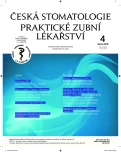-
Medical journals
- Career
Possibilities of Using an Expert System in the Diagnosis of Jaw Cysts
Authors: N. Mahdian; T. Dostálová; J. Feberová; M. Hubáček
Authors‘ workplace: Stomatologická klinika dětí a dospělých 2. LF UK a FN Motol, Praha
Published in: Česká stomatologie / Praktické zubní lékařství, ročník 113, 2013, 4, s. 52-56
Category: Short Communication
Věnováno prof. MUDr. Jiřímu Mazánkovi, DrSc., k životnímu jubileu
Overview
Introduction:
Expert systems are among the most successful applications of artificial intelligence. Since their own commercial introduction in the early 80‘s of the last century, they have undergone rapid develop-ment and now they are used in many fields of human activity, such as in science, technology, production, trade, etc. In recent years, they are more and more used in medicine.Matherials and methods:
In this paper, we point out the possibility of using the expert systems for diagnosis of diseases. Based on our experience in the treatment of mandibular bone cysts, we developed in our department an expert system for decision support in the diagnosis and treatment of jaw cysts. Then we compared the results of the differential diagnosis in the group of 36 patients, proposed by the expert system with final clinical diagnosis. In addition the possibility of using this system in practice is shown on the case report of a mandibular cyst.Results:
During the verification of expert system there was analyzed diagnosis in case of 36 patients with monitoring of fifteen markers. Based on this the expert system proposed differential diagnosis. Subsequently, the results of final histological diagnoses were compared with them, which suggested expert system. These results are in an article published in a table.Conclusion:
Expert systems should propose optimal solutions to problems as well as if them proposed expert. They use heuristic knowledge and their advantage is that the results they provide are the same and are not affected by external factors (time pressure, fatigue). On the other hand, the use of heuristic knowledge may seem to be a limiting factor, when the expert system solves very complex problems and does not analyze all possible variants.Key words:
dentistry – expert systém – cysts
Sources
1. Curry, M., Malpani, A., Li, R., Tantillo, T., Jog, A., Blanco, R., Ha, PK., Califano, J., Kumar, R., Richmon, J.: Objective assessment in residency-based training for transoral robotic surgery.Laryngoscope, roč. 122, 2012, č. 10, s. 2184–2192.
2. Feigenbaum, E. A.: Some challenges and grand challenges for computational intelligence. J. ACM., roč. 50, 2003, č. 1, s. 32–40.
3. Kyzas, P. A.: Evidence-based oral and maxillofacial surgery. J. Oral Maxillofac. Surg., roč. 66, 2008 č. 5, s. 973–986.
4. Manchikanti, L.: Evidence-based medicine, systematic reviews, and guidelines in interventional pain management, part I: introduction and general considerations. Pain Physician., roč. 11, 2008, č. 2, s. 161–186.
5. Nocini, P.F., Verlato, G., Frustaci, A., de Gemmis, A., Rigoni, G., De Santis, D.: Evidence-based dentistry in oral surgery: could we do better? Open Dent. J., roč. 16, 2010, č. 4, s. 77–83, http://milost.wz.cz/umi/referat/index.html
7. Payne, P. R.: Chapter 1: Biomedical knowledge integration. PloS. Comput. Biol., roč. 8, 2012, č. 12, s. e1002826 (1–15).
Labels
Maxillofacial surgery Orthodontics Dental medicine
Article was published inCzech Dental Journal

2013 Issue 4-
All articles in this issue
- Prevalence of Dental Anomalies in Orthodontic Patients
- Microbial Colonization of the Cleft
- Makrodesign of Implant – Types and Shapes of Threads Used and their Evaluation Using Finite Element Analysis
- Fibrous Hyperplasias of the Maxilla and Mandible in the Dental Records Archive of the Department of Stomatology and Maxillofacial Surgery in Bratislava
- Possibilities of Using an Expert System in the Diagnosis of Jaw Cysts
- Czech Dental Journal
- Journal archive
- Current issue
- Online only
- About the journal
Most read in this issue- Prevalence of Dental Anomalies in Orthodontic Patients
- Fibrous Hyperplasias of the Maxilla and Mandible in the Dental Records Archive of the Department of Stomatology and Maxillofacial Surgery in Bratislava
- Microbial Colonization of the Cleft
- Makrodesign of Implant – Types and Shapes of Threads Used and their Evaluation Using Finite Element Analysis
Login#ADS_BOTTOM_SCRIPTS#Forgotten passwordEnter the email address that you registered with. We will send you instructions on how to set a new password.
- Career

